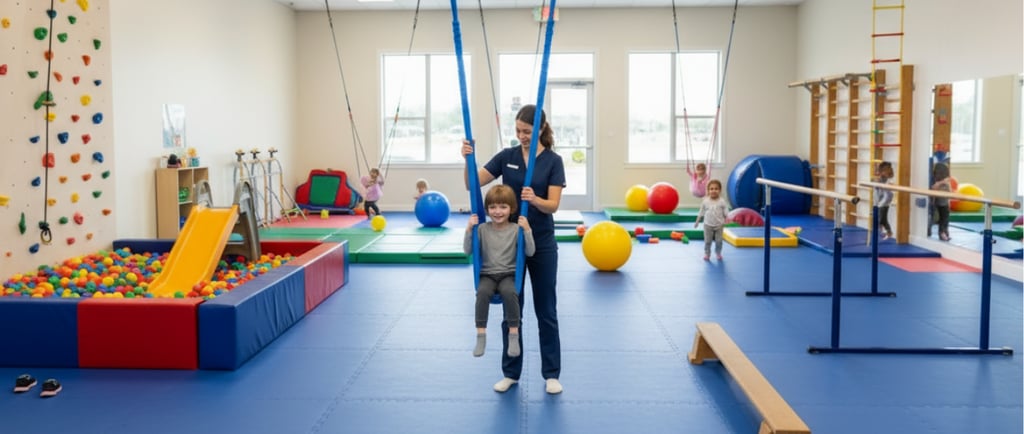What is Sensory Integration Therapy and How Can It Help Your Child?
Understanding Sensory Integration in detail
OCCUPATIONAL THERAPYSENSORY INTEGRATION
Dr. Dipak Kumar
9/30/20253 min read


Children learn, play, and interact with the world through their senses. Every sound, touch, smell, sight, and movement provides information that their brain needs to process. For most children, this happens naturally. But for some, the brain struggles to organize these sensory messages. This can make everyday activities—like dressing, eating, or playing with friends—feel overwhelming.
This is where Sensory Integration Therapy comes in. It is a specialized approach, often provided by occupational therapists, to help children process sensory input in a more organized and comfortable way.
What is Sensory Integration?
Sensory integration is the brain’s ability to receive, organize, and respond to information from the senses. These include not only the five senses we usually think of (sight, sound, taste, touch, and smell) but also:
Vestibular sense (movement and balance)
Proprioception (awareness of body position and movement)
When sensory integration works well, a child can focus in class, enjoy playtime, and manage daily routines. But when there’s a difficulty, a child may feel either overwhelmed (too sensitive to sounds, lights, textures) or under-responsive (seeking extra movement, pressure, or noise to feel regulated).
Why Do Some Children Struggle with Sensory Processing?
Challenges with sensory integration can appear in children with:
Autism Spectrum Disorder (ASD)
Attention Deficit Hyperactivity Disorder (ADHD)
Developmental delays
Learning difficulties
Or sometimes, without any specific diagnosis
Signs may include:
Covering ears at normal sounds
Disliking certain clothing textures or food textures
Constantly moving, spinning, or jumping
Difficulty sitting still and focusing
Strong emotional reactions in crowded or noisy places
These difficulties are often called Sensory Processing Challenges.
What is Sensory Integration Therapy?
Sensory Integration Therapy (SIT) is a structured approach developed to help children improve how their brain processes and responds to sensory information. An occupational therapist (OT) trained in sensory integration designs playful and engaging activities that challenge the child’s sensory systems in a safe, supportive way.
The therapy takes place in a specially designed environment with equipment such as swings, trampolines, climbing structures, textured mats, and weighted items.
How Does Therapy Work?
The goal is to provide the right balance of sensory input—not too much, not too little—so that the child can learn to process and respond in a more organized way.
Some examples of activities include:
Swings and Spinning Equipment
Stimulates the vestibular system (balance and movement).
Helps children who are either fearful of movement or constantly seeking it.
Textured Play (sand, playdough, rice bins, shaving foam)
Targets the tactile system.
Encourages tolerance of different textures, which helps with daily tasks like dressing or eating.
Weighted Blankets or Vests
Provide deep pressure input through the proprioceptive system.
Can help calm children who feel restless, anxious, or overstimulated.
Obstacle Courses and Climbing
Combine vestibular, proprioceptive, and motor skills.
Improve body awareness, coordination, and confidence.
Fine Motor Activities (beading, puzzles, threading)
Encourage focus and hand skills while integrating sensory feedback.
Benefits of Sensory Integration Therapy
With consistent sessions, children often show improvements in:
Attention and focus (better participation in school and learning tasks)
Emotional regulation (fewer meltdowns or shutdowns in overwhelming situations)
Motor skills (improved balance, coordination, and strength)
Daily independence (dressing, eating, brushing teeth, writing)
Social skills (feeling more comfortable in play and group settings)
It’s not a “quick fix” but a gradual process that builds the child’s ability to handle the world with more ease.
Why Work with an Occupational Therapist?
Occupational therapists trained in sensory integration carefully assess each child’s strengths and challenges. They create a personalized therapy plan that matches the child’s needs. Importantly, therapy looks like play for the child—but it’s structured play with a clear therapeutic purpose.
Parents are also guided with strategies to use at home, such as calming routines, safe movement breaks, or adapting the environment to support the child.
Sensory Integration Therapy can be life-changing for children who struggle with sensory processing. By improving the way the brain organizes and responds to sensory input it helps children gain confidence, independence, and joy in their daily activities.
If you notice your child often feels overwhelmed by sounds, textures, or movement—or constantly seeks more stimulation—it may be worth consulting an occupational therapist. With the right support, your child can thrive in a world full of sensory experiences.
Tags: Sensory Integration, Occupational Therapy, Child Development, Sensory Processing, Best Child Therapy in Hyderabad
Connect
Reach out for personalized child support
CONTACT US
Join our community
info@weecare.in
+91-8877 3535 14
WeeCare© 2025. All rights reserved.


Important links
We Accept


